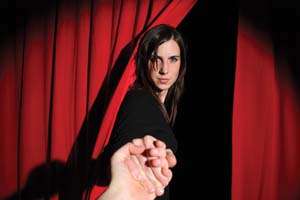Terrified by the prospect of engaging with one-on-one theatre? Sunita Pandya explains how a new festival designed for a solo theatre experience aims to shake up audience perception

Imagine trying to programme 45 artists from across the world, each performing for around three hours, with 150 different audience members having to experience at least three of these piece. Mindboggling? Definitely. But this was the logistical feat I was challenged to complete when scheduling the One-on-One Festival at Battersea Arts Centre (BAC). It is the first festival where the only work performed is by one artist for one audience member. Few theatres in the country could really take on this scale and type of festival as few have more than 45 spaces in-house which lend themselves to intimate work. Even fewer theatres decide to stage a festival where a very strictly limited number of people will experience the work. For the 2,400 people who walk through the doors at BAC and delve into One-on-One though, we want their experience to resonate on all levels – from a one-on-one with a butler serving a favourite drink, to a one-on-one with another audience member as they navigate the length and breadth of the old Town Hall building that BAC inhabits.
WHY ONE-ON-ONE?
It is with these ideas in mind that BAC decided to stage the festival, with the artistic programme lead by senior producer Richard Dufty. BAC’s Joint Artistic Directors David Jubb and David Micklem agree that “One-on-one theatre has provided some of the most honest, moving and occasionally disturbing moments we have ever had in the theatre. One-on-one work truly gets to the heart of the relationship between artist and audience, and when it’s good it can be completely transformational for audiences. It also provokes important ethical questions, reflecting the complexity and delicacy of human relationships.” When the curation of every audience member’s journey is in your hands, the success of the festival is very tangible for a producer like myself.
It goes with out saying that such an undertaking is a challenge that a producer relishes, but it’s also a challenge that causes some sleepless nights! My world for the past two months has been made up of numerous spreadsheets, mathematical calculations of how many slots need to be programmed to ensure value for money for every audience member, as well as rolling out the festival to the wider BAC staff team to ensure that everyone has a role (rather than all the information being locked in my head). For the festival to work and run smoothly, every department must have a strong sense of ownership of their input and know that they are fully supported in delivering it. At some stage, a producer has to relinquish control (for someone like me, that’s pretty tough!) and let each team do what they do best.
TREND-LED THEATRE
There are clear trends towards producing more one-on-one work and more intimate forms of theatre-making. Brighton Festival programmed a weekend of one-on-one work. Renowned Belgian company Ontroerond Goed presented ‘Internal’ at Bristol’s Mayfest, and Quarantine’s ‘The Soldier’s Song’ is touring to Manchester Art Gallery. One-on-one work is being programmed more widely, allowing greater access to audiences whilst challenging preconceptions. Of course when an audience member is told the show consists of them and one performer, it is understandable that it can seem scary, intimidating or intense. However the key to one-on-one work is context: the context of presentation; how an audience member is taken care of; how their experience allows moments of contemplation, of absorption, of laughter. Being shepherded from piece to piece wouldn’t allow the physical and emotive space one needs having seen one-on-one work, something I am acutely aware of when dealing with our designers, when liaising with front of house staff, and when signing off menus that will fuel punters on the night.
Ultimately, I think I will survive until the festival opens, torn between utter excitement and fear that the many logistical aspects might not all run to plan. If this festival breaks down some the perceived barriers of presenting and experiencing one-on-one work – creatively, logistically and personally – then it will have all been worth it. And if you see someone gulping a very strong G&T on opening night, you can bet that will be me…
Sunita Pandya is Producer at the Battersea Arts Centre, London. The One-on-One Festival will take place 6–10 July.
W http://www.bac.org.uk
This week Sunita went to the Brighton Festival and experienced the stunning piece by Dreamspeakthink, ‘Before I Sleep’, in the old Co-op building, as well as Tim Crouch’s electric ‘I, Malvolio’. She also enjoyed the Henry Moore exhibition at the Tate Britain – she’d read some negative reviews but she thought it was very engaging.



